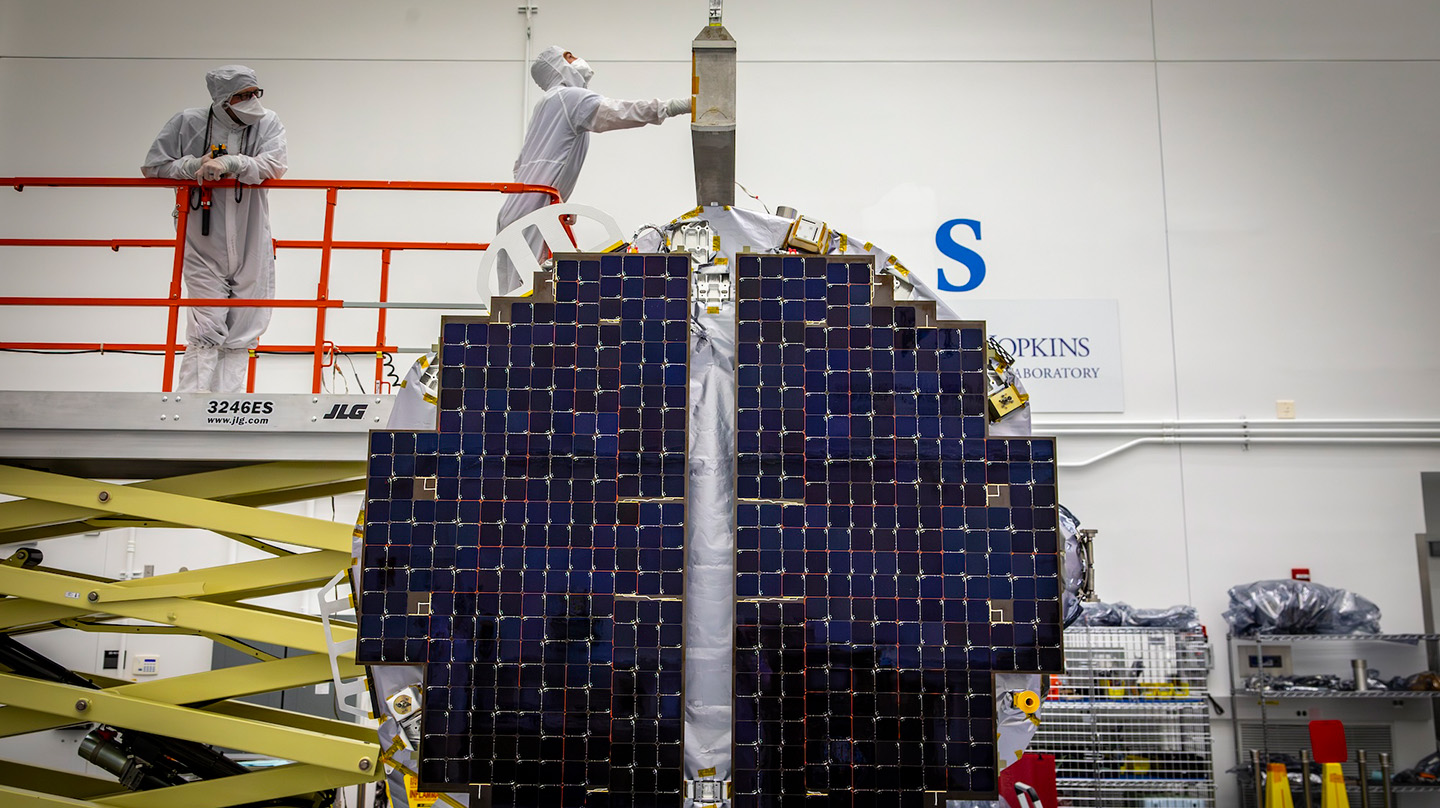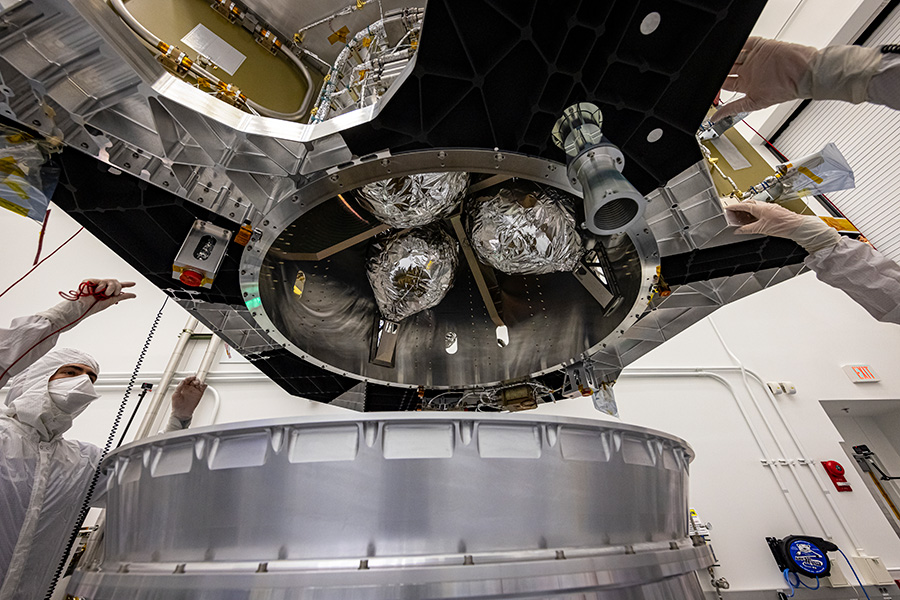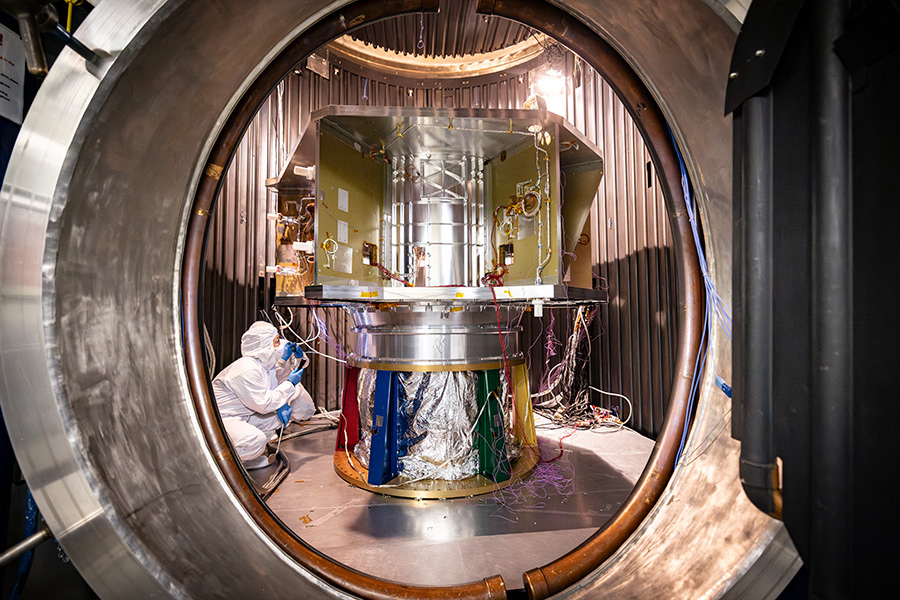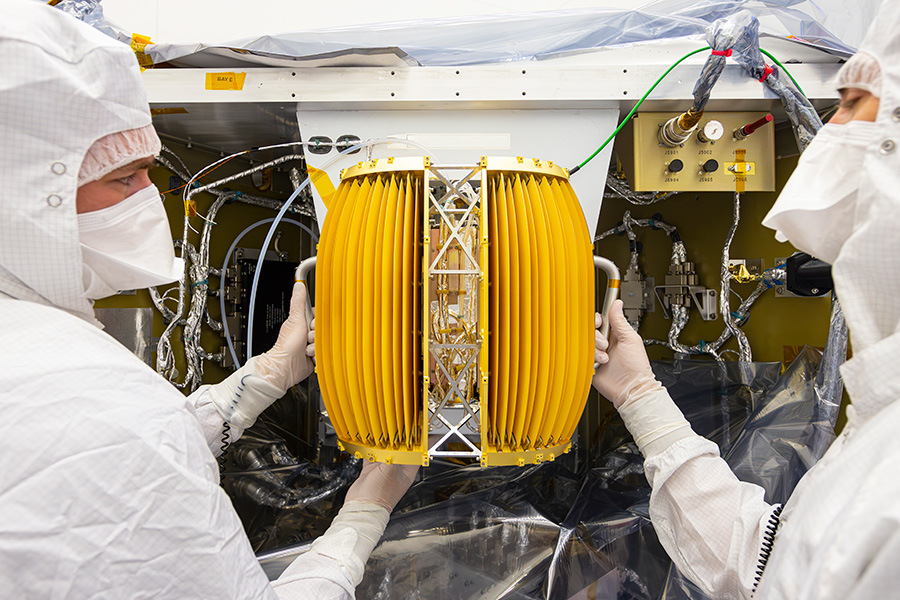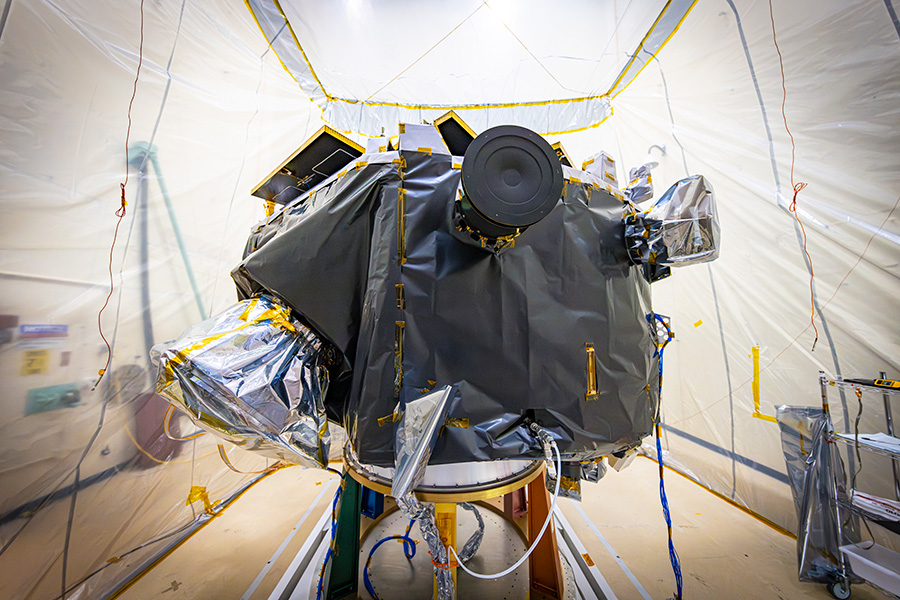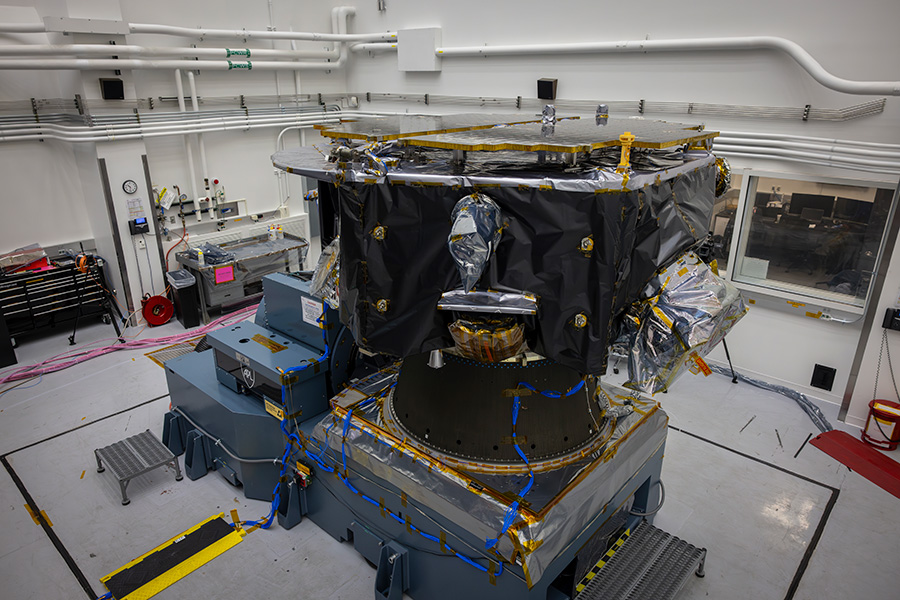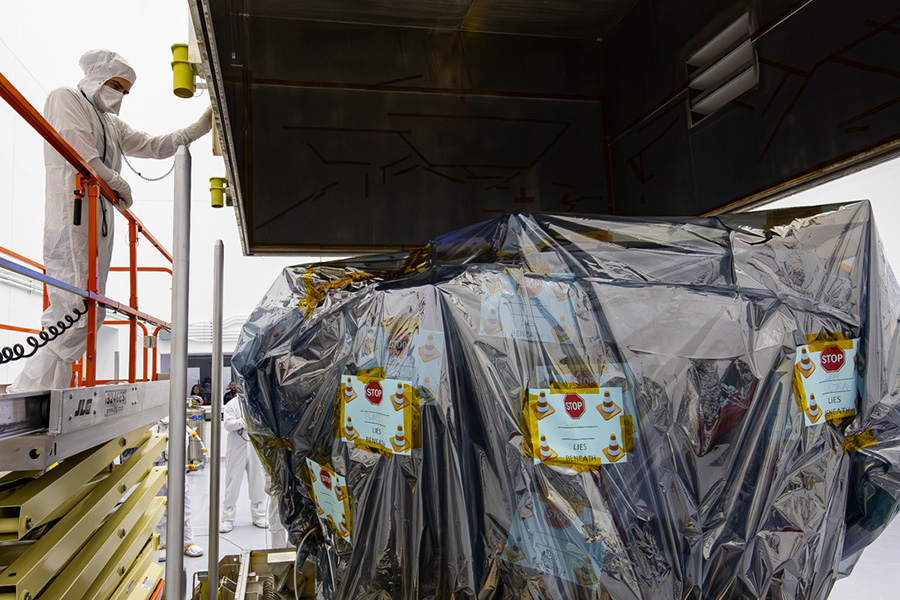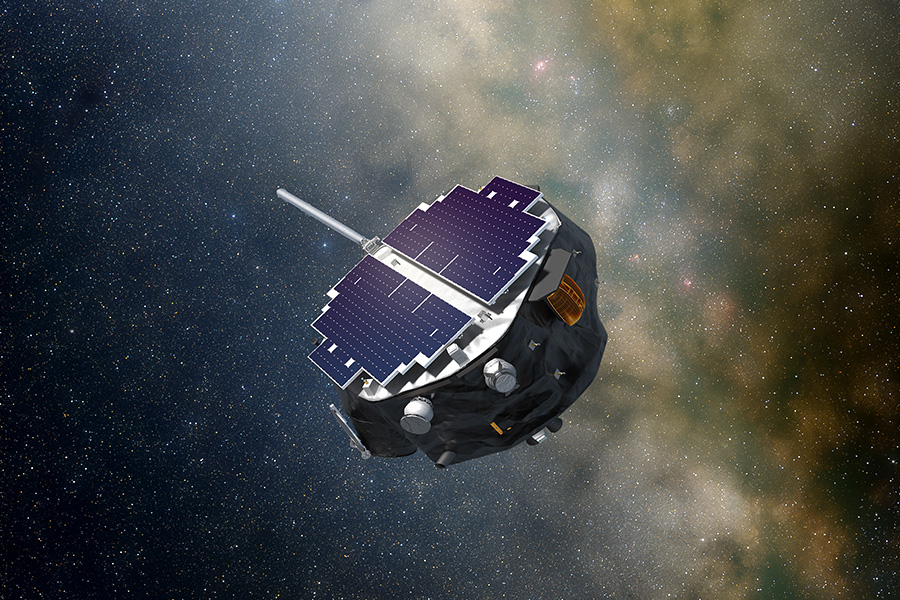Press Release
International Team Readies the Interstellar Mapping and Acceleration Probe for Launch
The final instrument set to fly on NASA’s Interstellar Mapping and Acceleration Probe (IMAP) — currently coming together at the Johns Hopkins Applied Physics Laboratory (APL) in Laurel, Maryland — has been integrated onto the spacecraft.
The IMAP mission will observe our solar neighborhood, decoding the messages in particles from the Sun and beyond. Like a modern-day celestial cartographer, the mission will map the boundaries of the heliosphere — the electromagnetic bubble surrounding the Sun and planets that is inflated by the solar wind and shields our solar system from cosmic radiation.
IMAP will also investigate and chart the vast range of particles in interplanetary space, helping to investigate how charged particles from the Sun are energized and how the solar wind interacts with interstellar space at the solar system’s boundary.
Most people hear the word “spacecraft” and envision rockets blasting into space, but they’re often not aware of the meticulous integration and testing campaigns — known as “I&T” — to get a spacecraft like IMAP ready for the launchpad.
Integration and Testing
In a complex process that took over a year, the IMAP instruments, subsystems and components were pulled together and run through a gauntlet of tests to ensure mission success.
Recently, IMAP underwent vibration testing, during which the spacecraft was vibrated over a range of frequencies to simulate the launch environment. It’s one of several tests conducted to ensure IMAP and its instruments can withstand the conditions of space travel.
“APL teams have consistently proven up to the challenge of preparing missions for the rigors of space travel, and IMAP is no exception,” said Andy Driesman, APL’s mission area executive for Civil Space Flight. “The IMAP team is using its experience and creativity to address the challenge of building a spacecraft with so many instruments.”
IMAP will fly 10 instruments built by multiple organizations to study the solar wind, interstellar dust and other particles in space. Among them is IMAP-Ultra, one of the three energetic neutral atom (ENA) imagers onboard IMAP, and designed and built by APL. IMAP-Ultra will help us understand how the heliospheric bubble, created by the Sun, protects the solar system. Ultra does so by accurately measuring the ENAs formed when charged particles from the solar wind reach the outer heliosphere and interact with neutral particles in interstellar space.
“Now that all the instruments have been integrated, we will focus on ensuring the spacecraft can endure the rigors of launch and life in space,” said Justin Hahn, the I&T lead for the IMAP mission. “The challenge with IMAP is the variety and number of instruments.”
Hahn’s team began this process by meeting with the groups building each instrument. After delivery, mechanical installation and a series of electrical checks, each instrument is connected to the IMAP spacecraft and powered on. Engineers perform additional tests and simulations, specific to each instrument, after it is integrated with the spacecraft.
By December, all 10 instruments were on board the IMAP spacecraft. They are listed below in the order they were integrated:
- Interstellar Dust Experiment (IDEX), designed and built by the Laboratory for Atmospheric and Space Physics in Boulder, Colorado, is a mass spectrometer studying interstellar dust and interplanetary dust particles.
- IMAP Magnetometer (MAG), designed and built by Imperial College London, is a pair of identical magnetometers that each measure the magnetic field near the spacecraft.
- IMAP-Ultra, designed and built by APL, features two ENA imagers to shed light on the evolution of the boundary region where the solar wind and interstellar medium interact. IMAP-Ultra maps the highest-energy-range ENAs.
- High-energy Ion Telescope (HIT), designed and built by NASA’s Goddard Space Flight Center, examines high-energy ions.
- Solar Wind Electron (SWE) instrument, designed and built by the Los Alamos National Laboratory (LANL) in collaboration with Southwest Research Institute (SwRI), examines electrons found in the solar wind.
- GLObal Solar Wind Structure (GLOWS) instrument, designed and built by the Space Research Center of the Polish Academy of Sciences in Warsaw, is a photometer that will investigate the solar wind and study its evolution over time.
- Solar Wind and Pickup Ion (SWAPI) instrument, designed and built by Princeton University, measures ions from the solar wind and particles from beyond the solar system.
- IMAP-Hi, designed and built by LANL in collaboration with SwRI, the University of New Hampshire (UNH) and the University of Bern in Switzerland, features two ENA imagers to help advance our understanding of the evolution of the boundary region where the solar wind and interstellar medium interact. IMAP-Hi maps the medium-energy-range ENAs.
- IMAP-Lo, designed and built by UNH in collaboration with SwRI, APL and the University of Bern, is an ENA imager mounted on a pivot platform to help advance our understanding of the evolution of the boundary region where the solar wind and interstellar medium interact. IMAP-Lo captures the lower-energy-range ENAs from the edge of our solar system, and also measures interstellar neutral particles from beyond our solar system.
- The Compact Dual Ion Composition Experiment (CoDICE), designed and assembled by SwRI, measures interstellar pickup ions and solar wind particles to provide insights into particle acceleration and the local interstellar medium.
IMAP is now running through a series of operations simulating the launch and postlaunch environments to ensure it can withstand the rigors of space. While at APL, along with mass properties testing, IMAP is undergoing vibration and separation shock testing, the latter of which replicates the spacecraft separating from the launch vehicle after liftoff.
“It takes a lot of coordination and planning from all the different groups involved,” said Hadi Navid, supervisor of APL’s Environmental Test Facility. “This is truly a team effort.”
A livestream of the clean room where the spacecraft is undergoing integration and testing is available on the IMAP mission website.
Princeton University professor and principal investigator David J. McComas leads IMAP with an international team of more than 25 partner institutions. APL is managing the development phase and building the spacecraft and will operate the mission. IMAP is the fifth mission in NASA’s Solar Terrestrial Probes (STP) Program portfolio. The Explorers and Heliophysics Projects Division at Goddard Space Flight Center manages the STP Program for the agency’s Heliophysics Division of NASA’s Science Mission Directorate.
